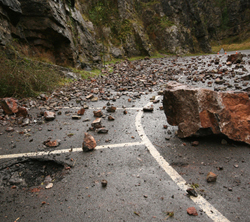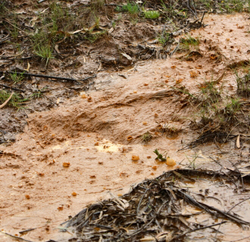

Landslides
Landslides and mudslides occur in all U.S. states and territories, and can be caused by a variety of factors including earthquakes, storms and fires. Areas that are not coverd by vegetation, especially following a fire, are more likely to have landslides or mudslides. This includes sliding, falling and flowing soil, rock, mud, brush and trees, particularly during or after heavy rains.
Landslides can occur quickly, often with little notice. Slow-moving landslides can cause significant property damage, but they usually do not cause injury or death.

Mudslides
Mudslides, however, are much more dangerous. According to the California Geological Survey, mudslides can easily exceed speeds of 10 miles per hour and often flow at rates of more than 20 mpr. Because mudslides travel much faster than landslides, they can cause deaths, injuries and significant property damage.
Landslides / mudslides can occur quickly, often with little notice, and the best way to prepare is to stay informed about changes in and around your home that could signal that a landslide / mudslide is likely to occur.
· Prepare for landslides by following proper land-use procedures - avoid building near steep slopes or along natural erosion valleys.
· Become familiar with the land around you. Learn whether debris flows have occurred in your area by contacting local officials. Slopes where debris flows have occurred in the past are likely to experience them in the future.
· Look for changes in landscape and water drainage, or new cracks in foundations and sidewalks.
· Consult a professional for advice on appropriate preventative measures for your home or business, such as flexible pipefittings, which can better resist breakage.
· Watch the patterns of storm-water drainage on slopes near your home or business, and note especially the places where runoff water converges, increasing flow over soil-covered slopes. Watch the hillsides around your home or business for signs of land movement, such as small landslides or debris flows or progressively titling trees.
Click here for additional information on landslides and mudslides.
Click here for additional information from FEMA on landslides and mudslides.Landslides/Mudslides Tornado/Windstorms Heat Emergency Cold Weather Hazardous Materials Terrorism





